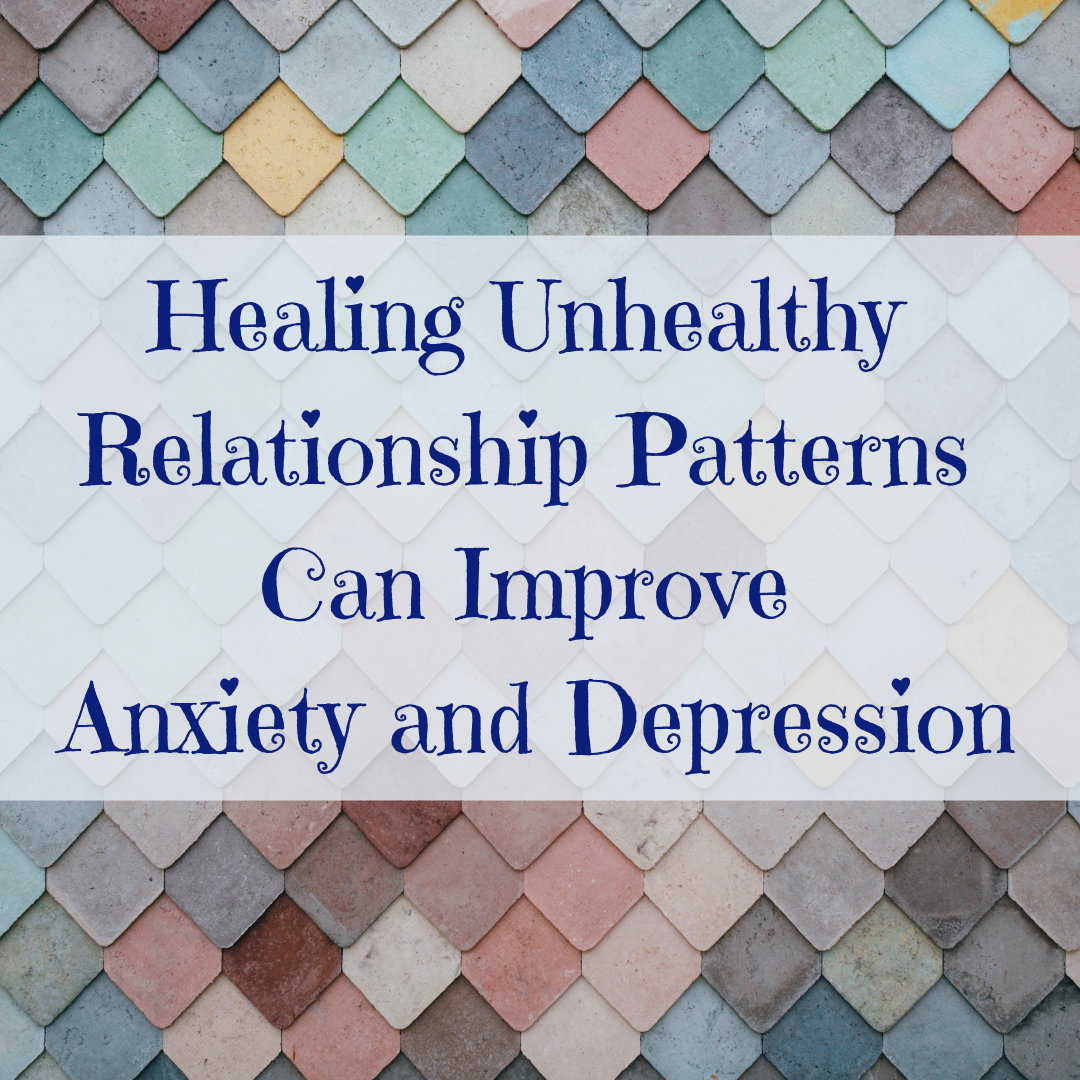Healing Unhealthy Relationship Patterns Can Improve Depression and Anxiety
Not always, but often, I find that many of the struggles that lead people to therapy, such as depression or anxiety, are associated with not getting needs met in relationships. This is most often apparent in romantic experiences or family dynamics but can also be seen in friendships and in problems with professional relationships. For this post, I will use romantic relationships as the primary example to highlight how relationship patterns work.
Patterns in our Relationships
If we look across your dating experiences or your patterns of romantic attraction, we can often find a pattern. Perhaps you are strong and independent and have deprioritized relationships despite having a longing for one. Perhaps you have had a pattern of being attracted to unavailable partners. Or maybe when you are in a relationship, you find yourself frequently feeling insecure and seeking reassurance or constant contact with a partner who becomes frustrated by your needs.
Some questions to ask as you reflect on your patterns are
1) What has been similar about my experiences of attraction?
2) What has been similar about the types of people I’m attracted to?
3) What has been similar about the way those I’m attracted to respond to me?
4) What is similar about my experiences of people who are attracted to me? (*for some, the people they are attracted to are not always the same as the people who are attracted to them).
If the problem seems to be more with friendships, you can ask similar questions to see if you can find a pattern.
Common Patterns (Styles)
There are a few different general styles of relating (patterns) that will often pop up, one style will tend to be associated with anxiety, a tendency to seek or need a lot of reassurance from the partner that they care for you, perhaps you initiate contact and attempts at closeness more than the other person does, or frequently worry about the security of the relationship, sometimes feeling like you need to do a lot to make sure the other person doesn’t go away or that they are satisfied with the relationship. You also may tend to be more preoccupied with what others are thinking and feeling than attuned to yourself. (Anxious style)
Another style tends to be highly independent and self-sufficient, feeling less of a need for relationships. You may be very good at focusing on other aspects of your life, such as your profession, but not as good at being open about your emotions, perhaps not even identifying that you have feelings or needs for closeness at all. If relationship problems occur, you may be more likely to withdraw or express yourself less rather than to move closer or seek comfort or reassurance. (Avoidant style)
And finally, there is a style that is called “disorganized,” which tends to be a combination of the two other styles, often using interpersonal strategies for getting your needs met that conflict with each other. Desiring safety and security but frequently feeling fearful in relationships is a characteristic of this style. These individuals often have the most difficult time getting their emotional/relational needs met. (Disorganized style)
Insecure Attachment
The styles above are called “attachment patterns” and are generally referred to respectively as
1) preoccupied anxious,
2) dismissive avoidant, and
3) disorganized (sometimes called fearful/avoidant).
These three fall into a category called “insecure attachment” which is a separate category from the healthier alternative, “secure attachment.”
Secure Attachment
Those who have a secure attachment style often seem to have an easier time engaging in relationships. They experience a sense of confidence and relationship security, trusting their partners, and feeling comfortable when together and apart. They tend to choose partners who are caring, attentive, and want to spend time with them. These couples are supportive of each others interests outside of the relationship, and both partners enjoy coming back together when not involved in these other activities.
Each of these patterns have a lot of depth to them, far more than can be said in a blog post. I am just giving a few common characteristics to help you discover whether you may fall into one of these categories. We all tend to be on a spectrum with some being more anxious or avoidant than others. Even those who are secure can be shaken and feel insecure in relationships at times.
One thing that can be challenging about our attachment styles is that we tend to choose partners who trigger the challenges associated with our attachment style. For instance, a person who needs more reassurance may find themselves choosing partners who are less available (or even avoidant) and perhaps even feeling repelled by partners who are too available.
Addressing Attachment Patterns
Relationship patterns are something I have a lot of interest in and really enjoy helping people with. It takes work and time, but I think it’s worth it. Often, addressing this problem helps to resolve other issues that you are experiencing, like depression. Relationships are important. We need meaningful human contact, to be noticed, cared for, and loved. When we learn how to get our needs met more effectively, it can help us to resolve other mental health related concerns.
So, what does a healthy secure attachment style look like?
In addition to what I wrote above, having a secure style often means having the experience of believing your needs will be met in your relationships, believing that you are loved and cared for by your partner and those in your life, trusting that when you ask for your needs to be met, your partner will do their best to meet them if they are able to, feeling safe to open up about your deepest concerns and needs, and knowing that your partner finds joy in you. You also find joy in them. There is a healthy sense of interdependence and you both maintain activities outside of the relationship. Those with a secure attachment style usually choose partners who are caring and attentive and secure themselves and tend to quickly lose interest in partners who are not.
Perhaps this sounds a little too perfect or even impossible to obtain. It is important to clarify that those who have a secure style still experience relationship conflict. Long-term relationships are hard and take work regardless of your level of security. However, having a fundamental belief that you are loved and safe in a relationship can make all the difference when it comes to working through problems, expressing your needs effectively and getting them met, and deciding which relationships to be in in the first place.
How do we move toward feeling more secure?
1) Therapy is a really important component to addressing insecure attachment. I highly recommend seeking therapy to anyone who struggles with relationships in these ways. Getting feedback and having regular weekly support can help with beginning to get your emotional needs met and to become aware of the ineffective ways in which you are relating. There are specific treatments that help with attachment and it often involves ways the therapist responds to the needs and behaviors you express over the course of therapy. It can also include specific exercises done in the therapy sessions and at home.
2) Begin a practice of mindfulness. Headspace is one popular app that makes this easier. Many of my clients really enjoy using Headspace. Mindfulness is helpful because it guides us to center and helps us to get in touch with what we’re really feeling. It helps us to learn to sit with difficult (or even exciting) emotions rather than avoid them or just react to them (by anxiously doing something in response, for instance). For those who are preoccupied with other people’s feelings, it can help you to re-attune to yourself and your needs and focus less on people pleasing or worrying about what others think of you.
3) Reflect on what the other person might be experiencing when you’ve had an interpersonal interaction, particularly in situations that are confusing or distressing. Taking some moments to journal about this can help you slow down and really give this some thought. *This exercise is not the same as being preoccupied with the other person’s feelings as a reaction to your needing reassurance or security in the relationship.
4) Pay attention to the balance of initiating contact with those you are interested in or care for. Do you initiate contact more than they do? Do they initiate contact more than you do? Begin to pay attention to how this really feels. If you are putting in more of the effort, it can be helpful to pull back and initiate only as much contact as they initiate and then sit with the feelings that arise as a result. (Mindfulness is helpful here). If you are someone who experiences others as putting in most of the effort, notice what that is like for you. What would it be like to experiment with increasing your effort to initiate contact with those you care for? How does that feel? (I don’t recommend increasing contact with someone who is abusive or toxic in your life. Focus on those you are interested in or care for and enjoy.)
5) Learn more about attachment. A lot has been written that can be found online and there is a popular book called Attached that I have not read personally, but some of my clients have found helpful. The book is not a complete picture, but it seems to be a very helpful introduction.
This is not an exhaustive explanation of attachment, but I hope it gives you a few insights to explore further and some exercises you can try to begin working on in this area of your life.
Get Updates about New Blog Posts
If you find these posts helpful, sign-up to receive notices of new posts here. I will never sell your information. You can unsubscribe at any time. View my privacy policy here.
About Melissa King
I am a licensed mental health counselor in New York City with a psychotherapy office in the neighborhood of Murray Hill in Manhattan. Find out more about me here. I'd love to hear from you. Email me if there's a topic you'd like to read about here.



